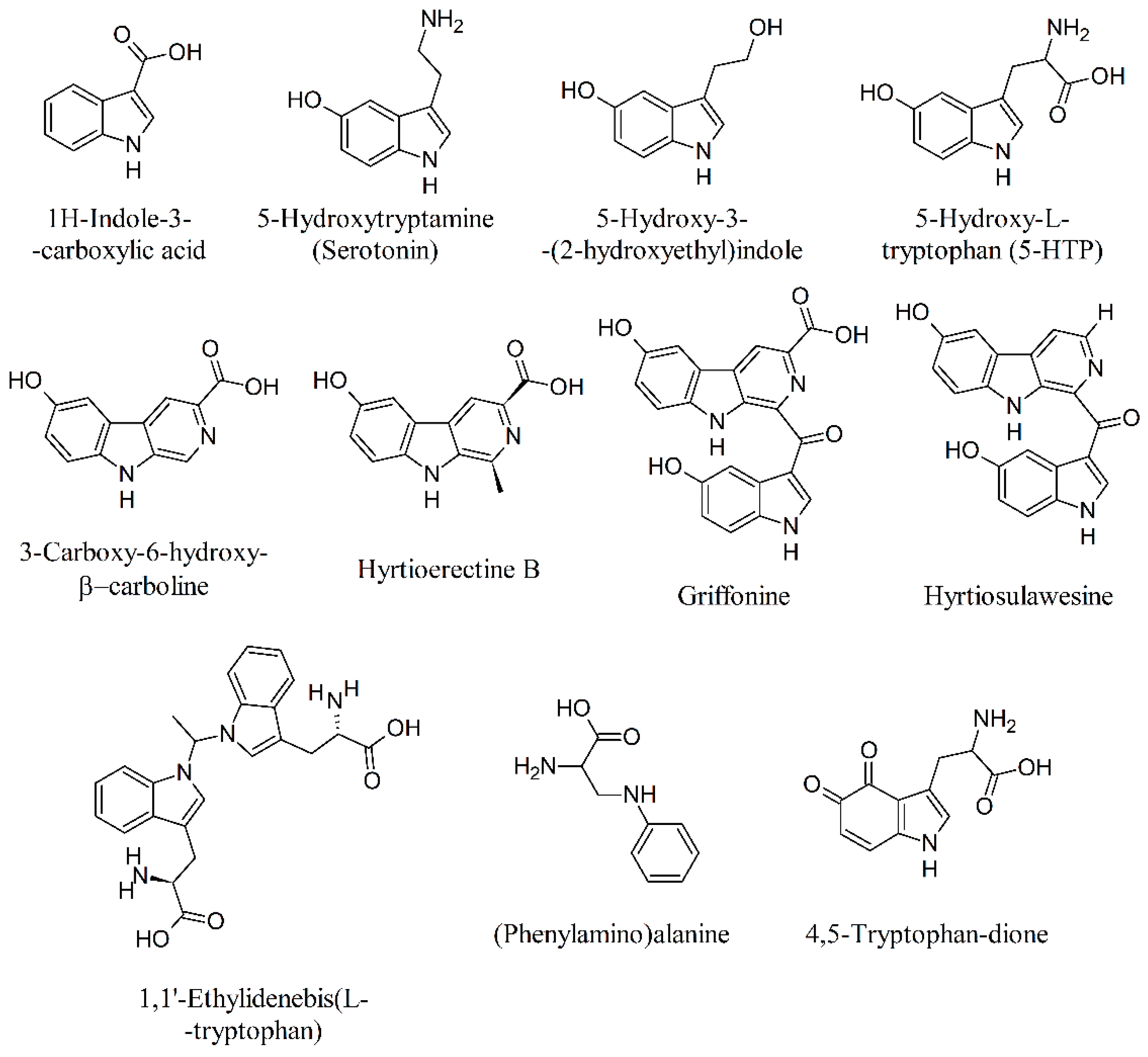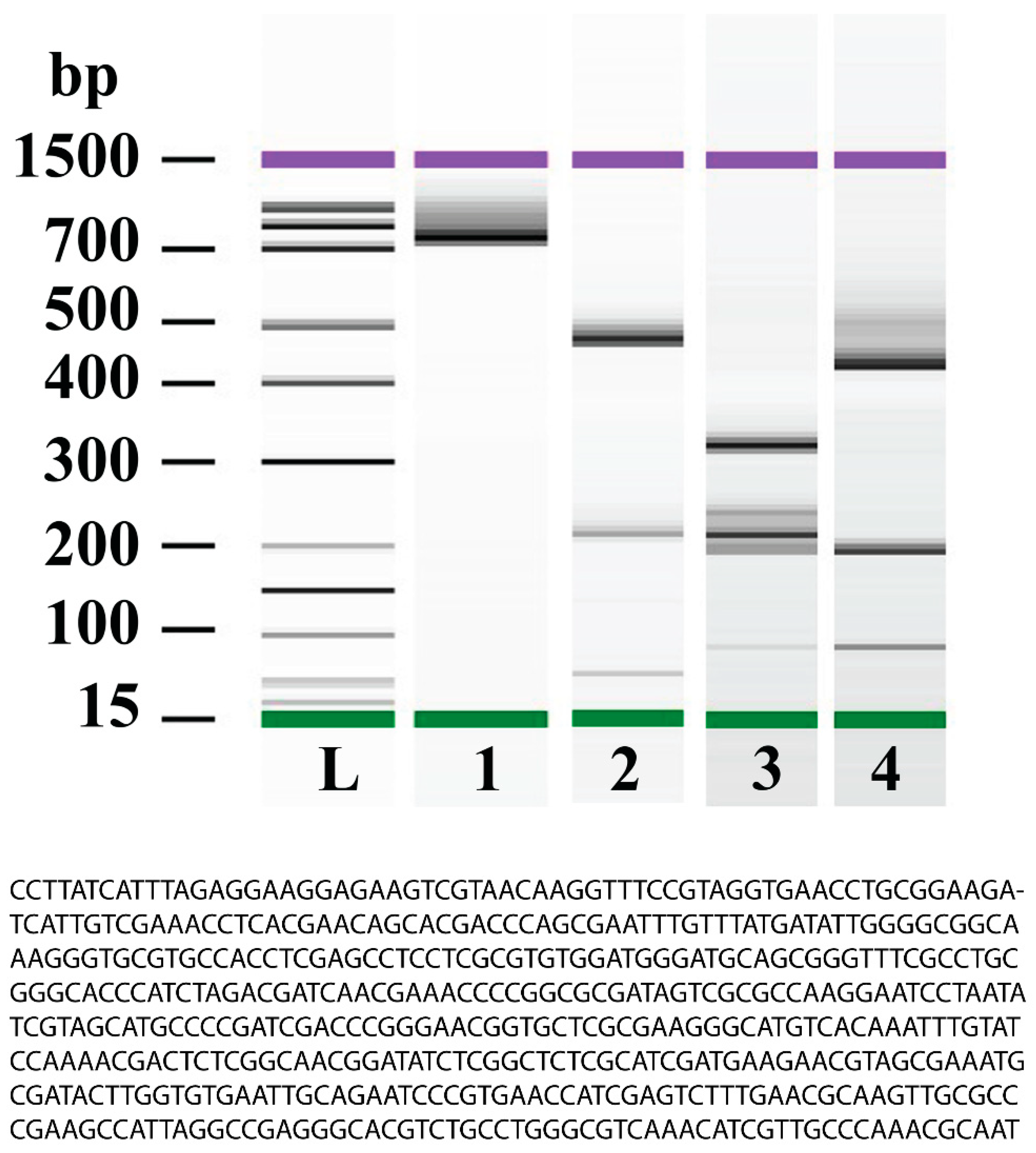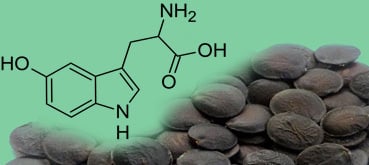Chemical Characterization and DNA Fingerprinting of Griffonia simplicifolia Baill.
Abstract
1. Introduction
2. Results and Discussion
2.1. 5-HTP Is the Major Nitrogen-Containing Compound of G. simplicifolia
2.2. Griffonia simplicifolia Seeds Show a High Content of Unsaturated Fatty Acids
2.3. DNA Fingerprinting of Griffonia simplicifolia Using PCR–RFLP Analysis
3. Materials and Methods
3.1. Plant Material
3.2. Extraction of 5-HTP and Other N-Containing Compounds
3.3. Identification and Quantification of 5-HTP and Other N-Containing Compounds
3.4. Identification and Quantification of Fatty Acids
3.5. DNA Extraction, PCR Amplification, Subcloning, and Sequencing
3.6. PCR–RFLP Analysis and DNA Fingerprinting
3.7. Statistical Analysis
4. Conclusions
Supplementary Materials
Author Contributions
Funding
Acknowledgments
Conflicts of Interest
References
- Petkov, G.; Ramazanov, Z. Fatty acids and sterols of Griffonia seeds oil. Grasas Aceites 2003, 54, 30–31. [Google Scholar] [CrossRef]
- Irvine, F.R. Woody Plants of Ghana; Oxford University Press: Oxford, UK, 1961. [Google Scholar]
- Zhu-Salzman, K.; Shade, R.E.; Koiwa, H.; Salzman, R.A.; Narasimhan, M.; Bressan, I.A.; Hasegawa, P.M.; Murdock, L.L. Carbohydrate binding and resistance to proteolysis control insecticidal activity of Griffonia simplicifolia lectin II. Proc. Natl. Acad. Sci. USA 1998, 95, 15123–15128. [Google Scholar] [CrossRef] [PubMed]
- Fellows, L.E.; Bell, E.A. 5-Hydroxy-l-tryptophan, 5-hydroxytryptamine and L-tryptophan-5-hydroxylase in Griffonia simplicifolia. Phytochemistry 1970, 9, 2389–2396. [Google Scholar] [CrossRef]
- Freedman, R.R. Treatment of menopausal hot flashes with 5-hydroxytryptophan. Maturitas 2010, 65, 383–385. [Google Scholar] [CrossRef] [PubMed]
- Kitahama, K.; Jouvet, A.; Fujimiya, M.; Nagatsu, I.; Arai, R. 5-hydroxytryptophan (5-HTP) uptake and decarboxylation in the kitten brain. J. Neural Transm. 2002, 109, 683–689. [Google Scholar] [CrossRef]
- Pranzatelli, M.R.; Galvan, I.; Tailor, P.T. Human brainstem serotonin receptors: Characterization and implications for subcortical myoclonus. Clin. Neuropharmacol. 1996, 19, 507–514. [Google Scholar] [CrossRef] [PubMed]
- Esposito, M.; Precenzano, F.; Sorrentino, M.; Avolio, D.; Carotenuto, M. A medical food formulation of Griffonia simplicifolia/magnesium for childhood periodic syndrome therapy: An open-label study on motion sickness. J. Med. Food 2015, 18, 916–920. [Google Scholar] [CrossRef]
- Muszynska, B.; Lojewski, M.; Rojowski, J.; Opoka, W.; Sulkowska-Ziaja, K. Natural products of relevance in the prevention and supportive treatment of depression. Psychiatr. Polska 2015, 49, 435–453. [Google Scholar] [CrossRef]
- Iovieno, N.; Dalton, E.D.; Fava, M.; Mischoulon, D. Second-tier natural antidepressants: Review and critique. J. Affect. Disord. 2011, 130, 343–357. [Google Scholar] [CrossRef]
- Emanuele, E.; Bertona, M.; Minoretti, P.; Geroldi, D. An open-label trial of L-5-hydroxytryptophan in subjects with romantic stress. Neuroendocrinol. Lett. 2010, 31, 663–666. [Google Scholar]
- Carnevale, G.; Di Viesti, V.; Zavatti, M.; Zanoli, P. Anxiolytic-like effect of Griffonia simplicifolia Baill. seed extract in rats. Phytomedicine 2011, 18, 848–851. [Google Scholar] [CrossRef]
- Carnevale, G.; Di Viesti, V.; Zavatti, M.; Benelli, A.; Zanoli, P. Griffonia simplicifolia negatively affects sexual behavior in female rats. Phytomedicine 2010, 17, 987–991. [Google Scholar] [CrossRef]
- Wang, X.Z.; Wu, F.H.; Qu, W.; Liang, J.Y. A new beta-carboline alkaloid from the seeds of Griffonia simplicifolia. Chin. J. Nat. Med. 2013, 11, 401–405. [Google Scholar] [CrossRef]
- Lemaire, P.A.; Adosraku, R.K. An HPLC method for the direct assay of the serotonin precursor, 5-hydroxytrophan, in seeds of Griffonia simplicifolia. Phytochem. Anal. 2002, 13, 333–337. [Google Scholar] [CrossRef]
- Koppisetti, G.; Siriki, A.; Sukala, K.; Subbaraju, G.V. Estimation of L-5-hydroxytryptophan in rat serum and Griffonia seed extracts by liquid chromatography-mass spectrometry. Anal. Chim. Acta 2005, 549, 129–133. [Google Scholar] [CrossRef]
- Kim, K.S.; Juliani, H.R.; Bucuk, M.; Acquaye, D.; Asante-Dartey, J.; Wu, Q.L.; Simon, J.E. Quality control and 5-HTP (5-Hydroxy-L-tryptophan) Analysis of Griffonia (Griffonia simplicifolia (DC.) Baill.) seed accessions collected in Ghana. In African Natural Plant Products: New Discoveries and Challenges in Chemistry and Quality; Juliani, H.R., Simon, J.E., Ho, C.T., Eds.; American Chemical Society: Washington, DC, USA, 2009; Volume 1021, pp. 381–390. [Google Scholar]
- Lin, Y.H.; Sun, X.X.; Yuan, Q.P.; Yan, Y.J. Engineering bacterial phenylalanine 4-hydroxylase for microbial synthesis of human neurotransmitter precursor 5-hydroxytryptophan. ACS Synth. Biol. 2014, 3, 497–505. [Google Scholar] [CrossRef]
- Hara, R.; Kino, K. Enhanced synthesis of 5-hydroxy-L-tryptophan through tetrahydropterin regeneration. AMB Express 2013, 3. [Google Scholar] [CrossRef]
- Belongia, E.A.; Hedberg, C.W.; Gleich, G.J.; White, K.E.; Mayeno, A.N.; Loegering, D.A.; Dunnette, S.L.; Pirie, P.L.; Macdonald, K.L.; Osterholm, M.T. An investigation of the cause of the eosinophilia-myalgia syndrome associated with tryptophan use. N. Engl. J. Med. 1990, 323, 357–365. [Google Scholar] [CrossRef]
- Mayeno, A.N.; Lin, F.; Foote, C.S.; Loegering, D.A.; Ames, M.M.; Hedberg, C.W.; Gleich, G.J. Characterization of Peak-E, a novel amino-acid associated with eosinophilia-myalgia-syndrome. Science 1990, 250, 1707–1708. [Google Scholar] [CrossRef]
- Goda, Y.; Suzuki, J.; Maitani, T.; Yoshihira, K.; Takeda, M.; Uchiyama, M. 3-Anilino-l-alanine, structural determination of UV-5, a contaminant in EMS-associated l-tryptophan samples. Chem. Pharm. Bull. 1992, 40, 2236–2238. [Google Scholar] [CrossRef]
- Gnavi, G.; Bertea, C.M.; Maffei, M.E. PCR, sequencing and PCR-RFLP of the 5S-rRNA-NTS region as a tool for the DNA fingerprinting of medicinal and aromatic plants. Flavour Fragr. J 2010, 25, 132–137. [Google Scholar] [CrossRef]
- Cheng, T.; Xu, C.; Lei, L.; Li, C.H.; Zhang, Y.; Zhou, S.L. Barcoding the kingdom Plantae: New PCR primers for ITS regions of plants with improved universality and specificity. Mol. Ecol. Res. 2016, 16, 138–149. [Google Scholar] [CrossRef] [PubMed]
- Coelho, A.G.; Aguiar, F.P.C.; de Jesus, D.P. A Rapid and simple method for determination of 5-hydroxytryptophan in dietary supplements by capillary electrophoresis. J. Braz. Chem. Soc. 2014, 25, 783–787. [Google Scholar] [CrossRef]
- Babu, S.K.; Ramakrishna, T.; Subbaraju, G.V. HPLC estimation of 5-hydroxytryptophan in Griffonia simplicifolia extracts. Asian J. Chem. 2005, 17, 506–510. [Google Scholar]
- Klarskov, K.; Johnson, K.L.; Benson, L.M.; Cragun, J.D.; Gleich, G.J.; Wrona, M.; Jiang, X.R.; Dryhurst, G.; Naylor, S. Structural characterization of a case-implicated contaminant, “Peak X,” in commercial preparations of 5-hydroxytryptophan. J. Rheumatol. 2003, 30, 89–95. [Google Scholar] [PubMed]
- Youssef, D.T.A. Hyrtioerectines A-C, cytotoxic alkaloids from the Red Sea sponge Hyrtios erectus. J. Nat. Prod. 2005, 68, 1416–1419. [Google Scholar] [CrossRef]
- Sato, F.; Hagiwara, Y.; Kawase, Y. Subchronic toxicity of 3-Phenylamino alanine, an impurity in l-Tryptophan reported to be associated with eosinophilia-myalgia-syndrome. Arch. Toxicol. 1995, 69, 444–449. [Google Scholar] [CrossRef] [PubMed]
- Murray, M.T. 5-HTP: The Natural Way to Overcome Depression, Obesity, and Insomnia; Bantam Books: New York, NY, USA, 1998. [Google Scholar]
- Mannino, G.; Occhipinti, A.; Maffei, M.E. Quantitative determination of 3-O-Acetyl-11-Keto-beta-Boswellic Acid (AKBA) and other boswellic acids in Boswellia sacra Flueck (syn. B. carteri Birdw) and Boswellia serrata Roxb. Molecules 2016, 21, 1329. [Google Scholar] [CrossRef]
- Christie, W.W.; Han, X. Lipid Analysis, 4th ed.; Woodhead Publishing: Oxford, UK, 2010. [Google Scholar]
- Mannino, G.; Gentile, C.; Maffei, M.E. Chemical partitioning and DNA fingerprinting of some pistachio (Pistacia vera L.) varieties of different geographical origin. Phytochemistry 2019, 160, 40–47. [Google Scholar] [CrossRef]
- Capuzzo, A.; Maffei, M.E. Molecular fingerprinting of some Mentha species by sequencing and RFLP analysis of the 5S-rRNA non-transcribed spacer region. Plant Biosyst. 2014, 148, 683–690. [Google Scholar] [CrossRef]
Sample Availability: Samples of the Griffonia simplicifolia extract are available from the authors. |


| Compound | MW | [M + H]+ | m/z | mg g−1 d.wt. | SD | Relative Percentage | ||
|---|---|---|---|---|---|---|---|---|
| 1H-indole-3-carboxylic acid | 161.0 | 162.0 | 143.8 | 115.9 | 0.08 | 0.006 | 0.04 | |
| 5-hydroxytryptamine | 176.0 | 177.0 | 158.8 | 135.8 | 117.0 | 1.15 | 0.066 | 0.64 |
| 5-hydroxy-3-(2-hydroxyethyl)indole | 177.0 | 178.0 | 159.8 | 132.9 | 115.0 | 0.27 | 0.006 | 0.15 |
| 5-hydroxy-l-tryptophan (5-HTP) | 220.0 | 221.0 | 204.0 | 161.9 | 156.48 | 8.320 | 86.48 | |
| 3-carboxy-6-hydroxy-β-carboline | 228.0 | 229.0 | 210.0 | 183.0 | 101.1 | 2.69 | 0.120 | 1.49 |
| hyrtioerectine B | 246.0 | 247.0 | 229.9 | 203.9 | 174.0 | 6.75 | 0.320 | 3.73 |
| griffonine | 329.0 | 330.0 | 167.9 | 0.75 | 0.030 | 0.41 | ||
| hyrtiosulawesine | 343.0 | 344.0 | 228.9 | 200.9 | 182.9 | 0.9 | 0.030 | 0.50 |
| 1,1′-ethylidenebis(l-tryptophan) | 434.0 | 435.0 | 231.0 | n.d. | n.d. | n.d. | ||
| 3-(phenylamino)alanine | 180.0 | 181.0 | 106.0 | 88.0 | 70.0 | n.d. | n.d. | n.d. |
| 4,5-tryptophan-dione | 234.0 | 235.0 | 217.0 | 162.0 | 181.0 | 11.87 | 0.92 | 6.56 |
| TOTAL | 181.10 | 16.10 | 100.00 | |||||
| Fatty Acid | Kovat’s Index | mg/g | SD | Relative Percentage |
|---|---|---|---|---|
| palmitic acid | 1942 | 18.22 | 0.93 | 11.06% |
| linoleic acid | 2095 | 91.24 | 5.74 | 55.38% |
| oleic acid | 2113 | 20.24 | 1.13 | 12.28% |
| stearic acid | 2187 | 32.12 | 2.25 | 19.50% |
| arachidic acid | 2359 | 10.39 | 0.65 | 6.31% |
| behenic acid | 2400 | 4.65 | 0.32 | 2.82% |
| TOTAL | 164.76 | 11.09 | 100.00% |
© 2019 by the authors. Licensee MDPI, Basel, Switzerland. This article is an open access article distributed under the terms and conditions of the Creative Commons Attribution (CC BY) license (http://creativecommons.org/licenses/by/4.0/).
Share and Cite
Vigliante, I.; Mannino, G.; Maffei, M.E. Chemical Characterization and DNA Fingerprinting of Griffonia simplicifolia Baill. Molecules 2019, 24, 1032. https://doi.org/10.3390/molecules24061032
Vigliante I, Mannino G, Maffei ME. Chemical Characterization and DNA Fingerprinting of Griffonia simplicifolia Baill. Molecules. 2019; 24(6):1032. https://doi.org/10.3390/molecules24061032
Chicago/Turabian StyleVigliante, Ivano, Giuseppe Mannino, and Massimo E. Maffei. 2019. "Chemical Characterization and DNA Fingerprinting of Griffonia simplicifolia Baill." Molecules 24, no. 6: 1032. https://doi.org/10.3390/molecules24061032
APA StyleVigliante, I., Mannino, G., & Maffei, M. E. (2019). Chemical Characterization and DNA Fingerprinting of Griffonia simplicifolia Baill. Molecules, 24(6), 1032. https://doi.org/10.3390/molecules24061032








